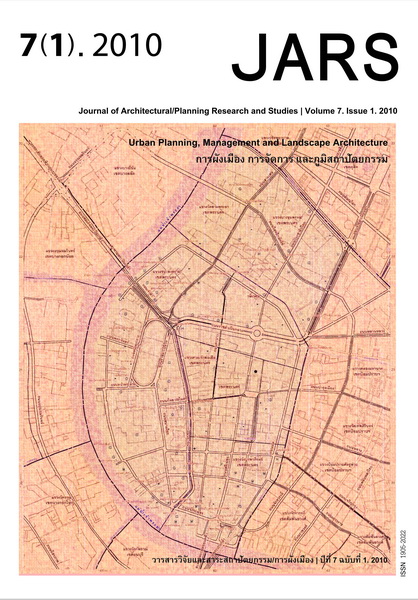Assessing Commuter Demands on New Public Transit Project: A Case Study of Campus Community
Main Article Content
Abstract
This paper presents the results of a qualitative study of stated choice designs to assess commuting and
non-commuting demands. Base on this assessment, the exploration of the perceptions on public transport
service in the presence of new public transport infrastructure could be performed. The case study of university
community was selected in order to obtain a deeper understanding of travelers’ attitudes towards transportation
development. The key findings indicated that in order to increase public transport usage, the service should be
planned in a way to accommodate travelers. Furthermore, the choices of transports are influenced by several
factors, such as socioeconomic characteristics, travel behaviors and attitudes. Policies which aim to enhance
the ridership of overhaul should be targeted on the consideration of effective supporting network along with an
incorporating with land use planning to reduce frequency of car users.
Downloads
Article Details

This work is licensed under a Creative Commons Attribution-NonCommercial-NoDerivatives 4.0 International License.
All material is licensed under the terms of the Creative Commons Attribution 4.0 International (CC-BY-NC-ND 4.0) License, unless otherwise stated. As such, authors are free to share, copy, and redistribute the material in any medium or format. The authors must give appropriate credit, provide a link to the license, and indicate if changes were made. The authors may do so in any reasonable manner, but not in any way that suggests the licensor endorses you or your use. The authors may not use the material for commercial purposes. If the authors remix, transform, or build upon the material, they may not distribute the modified material, unless permission is obtained from JARS. Final, accepted versions of the paper may be posted on third party repositories, provided appropriate acknowledgement to the original source is clearly noted.
References
Asian Development Bank (ADB). (2005). Performance evaluation report: Bangkok urban transport project (Loan 1195-THA in Thailand). Retrieved November 2005, from www.adb.org
Beirao, G., & Cabral, J., S. (2007). Understanding attitudes towards public transport and private car: A qualitative study, Transport Policy, 14, 478-489.
Cervero, R. (1995). Mixed land-uses and commuting: Evidence from the American housing servey. Transportation Research Part A, 30(5), 361-377.
Givoni, M., & Rietveld, P. (2007). The access journey to the railway station and its role in passengers’ satisfaction with rail trave. Transport Policy, 14, 357-365.
Hensher, D. A., & Rose, J. M. (2007). Development of commuter and non-commuter mode choice models for assessment of new public transport infrastructure project: A case study. Transportation Research Part A, 41, 428-443.
IMAC. (September, 2005). The intermodal service integration for improvement of mobility, accessibility, sustainability and livelihood for Bangkok Metropolitan Region (BMR) and surrounding area. Final Report Vol. II: Main Report, Report prepared for Office of Transport and Traffic Policy and Planning (OTP), Asian Engineering Consultants Corp., Ltd. Pacific Consultants International, TESCO Ltd. and Transconsult CO., Ltd.
Office of Transport and Traffic Policy and Planning (OTP). (2004). The statistics of road network and number of vehicle in Bangkok. Retrieved May 2009, from http://www.otp.go.th/
Tang, S., & Lo, H. K. (2008). The impact of public transport policy on the viability and sustainability of mass railway transit—The Hong Kong experience. Transportation Research Part A, 42, 563-576.
Transportation and Growth Management (TGM). (2003). Connecting transportation & land use planning: Transit
oriented development, University of Oregon. Retrieved June 2009, from http://www.rrregion.org/pdf/publications/transportation/RRRC%20Transit%20Oriented%20Development%202006.pdf
URMAP. (2001). Mass transit: Urban rail transportation master plan (BMA and surrounding areas), December 2001. Bangkok, Thailand: Office of Transport and Traffic Policy and Planning (OTP).
World Bank. (2007). Strategic urban transport policy directions for Bangkok, June 2007. Bangkok, Thailand: World Bank.


